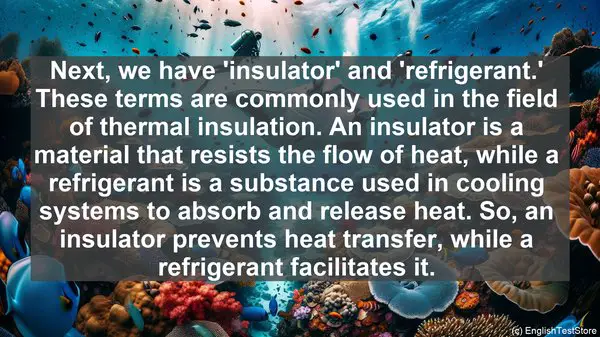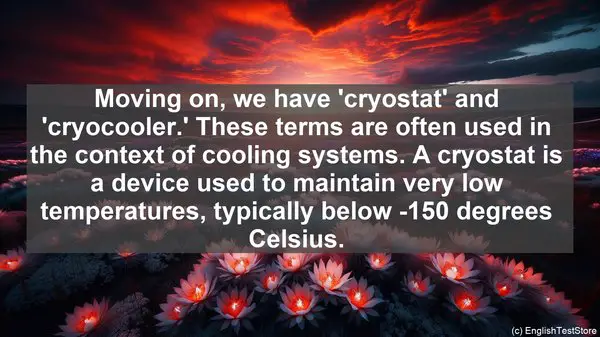Introduction to Cryogenics
Welcome to today’s lesson on cryogenics. Before we dive into the topic, let’s quickly understand what cryogenics is. It is the branch of physics that deals with the production and effects of very low temperatures. Now, let’s move on to our main focus – the commonly confused words in cryogenics.
1. Cryogenics vs. Cryonics
The first pair of words that often causes confusion is ‘cryogenics’ and ‘cryonics.’ While both words are related to low temperatures, they have different meanings. Cryogenics is the study of extremely low temperatures, whereas cryonics is the practice of preserving bodies at very low temperatures with the hope of future revival. So, remember, cryogenics is the science, and cryonics is the preservation method.

2. Superconductivity vs. Superfluidity
Next, we have ‘superconductivity’ and ‘superfluidity.’ These terms are used to describe the behavior of certain materials at low temperatures. Superconductivity refers to the complete absence of electrical resistance in a material, while superfluidity is the ability of a fluid to flow without any viscosity. So, in simple terms, superconductivity relates to electricity, and superfluidity relates to fluids.
3. Evaporation vs. Boiling
Moving on, we have ‘evaporation’ and ‘boiling.’ Both processes involve the conversion of a liquid into a gas, but they occur at different temperatures. Evaporation happens at the surface of a liquid, even at room temperature, whereas boiling occurs throughout the liquid when it reaches its boiling point. So, evaporation is a slower process, while boiling is rapid and more noticeable.
4. Latent Heat vs. Sensible Heat
Now, let’s discuss ‘latent heat’ and ‘sensible heat.’ These terms are used to describe the heat transfer during phase changes. Latent heat is the heat absorbed or released during a phase change, such as from solid to liquid or liquid to gas, without any change in temperature. On the other hand, sensible heat is the heat that causes a change in temperature without a phase change. So, latent heat is about phase changes, while sensible heat is about temperature changes.
5. Conduction vs. Convection
In the context of heat transfer, ‘conduction’ and ‘convection’ are often confused. Conduction is the transfer of heat through direct contact between particles, such as in a metal rod. Convection, on the other hand, involves the transfer of heat through the movement of a fluid, such as air or water. So, conduction is about direct contact, while convection involves fluid movement.
6. Insulator vs. Refrigerant
Next, we have ‘insulator’ and ‘refrigerant.’ These terms are commonly used in the field of thermal insulation. An insulator is a material that resists the flow of heat, while a refrigerant is a substance used in cooling systems to absorb and release heat. So, an insulator prevents heat transfer, while a refrigerant facilitates it.
7. Dewar Flask vs. Thermos
Now, let’s talk about ‘Dewar flask’ and ‘thermos.’ Both are types of containers used for keeping substances at low temperatures, but they have different designs. A Dewar flask has a double-walled construction with a vacuum between the walls, which minimizes heat transfer. A thermos, on the other hand, also has a double-walled construction but includes a reflective coating to further reduce heat transfer. So, while both are effective at insulation, a thermos provides better heat retention.
8. Cryostat vs. Cryocooler
Moving on, we have ‘cryostat’ and ‘cryocooler.’ These terms are often used in the context of cooling systems. A cryostat is a device used to maintain very low temperatures, typically below -150 degrees Celsius. A cryocooler, on the other hand, is a device used to cool objects or materials to cryogenic temperatures. So, a cryostat is about temperature maintenance, while a cryocooler is about temperature reduction.

9. Frost vs. Ice
Let’s now discuss the difference between ‘frost’ and ‘ice.’ Both are forms of frozen water, but they have different characteristics. Frost is formed when water vapor directly changes into ice crystals, typically on a cold surface. Ice, on the other hand, is formed from the freezing of liquid water. So, frost is a direct solidification of water vapor, while ice is the result of liquid water freezing.
10. Cryobiology vs. Cryonics
Lastly, we have ‘cryobiology’ and ‘cryonics.’ While these words sound similar, they have distinct meanings. Cryobiology is the branch of biology that studies the effects of low temperatures on living organisms, while cryonics, as we discussed earlier, is the preservation of bodies at low temperatures. So, cryobiology is about studying, and cryonics is about preservation.
